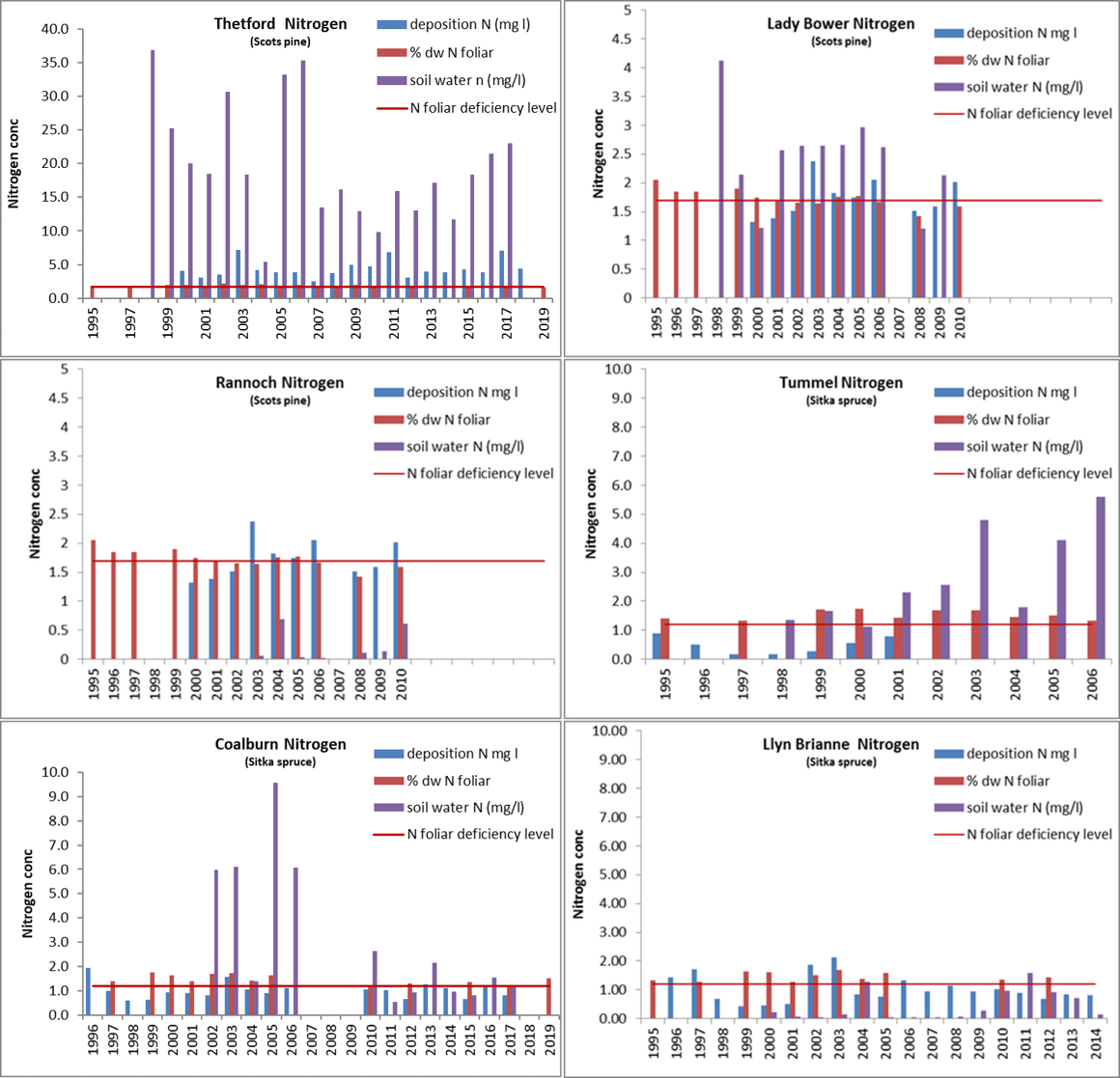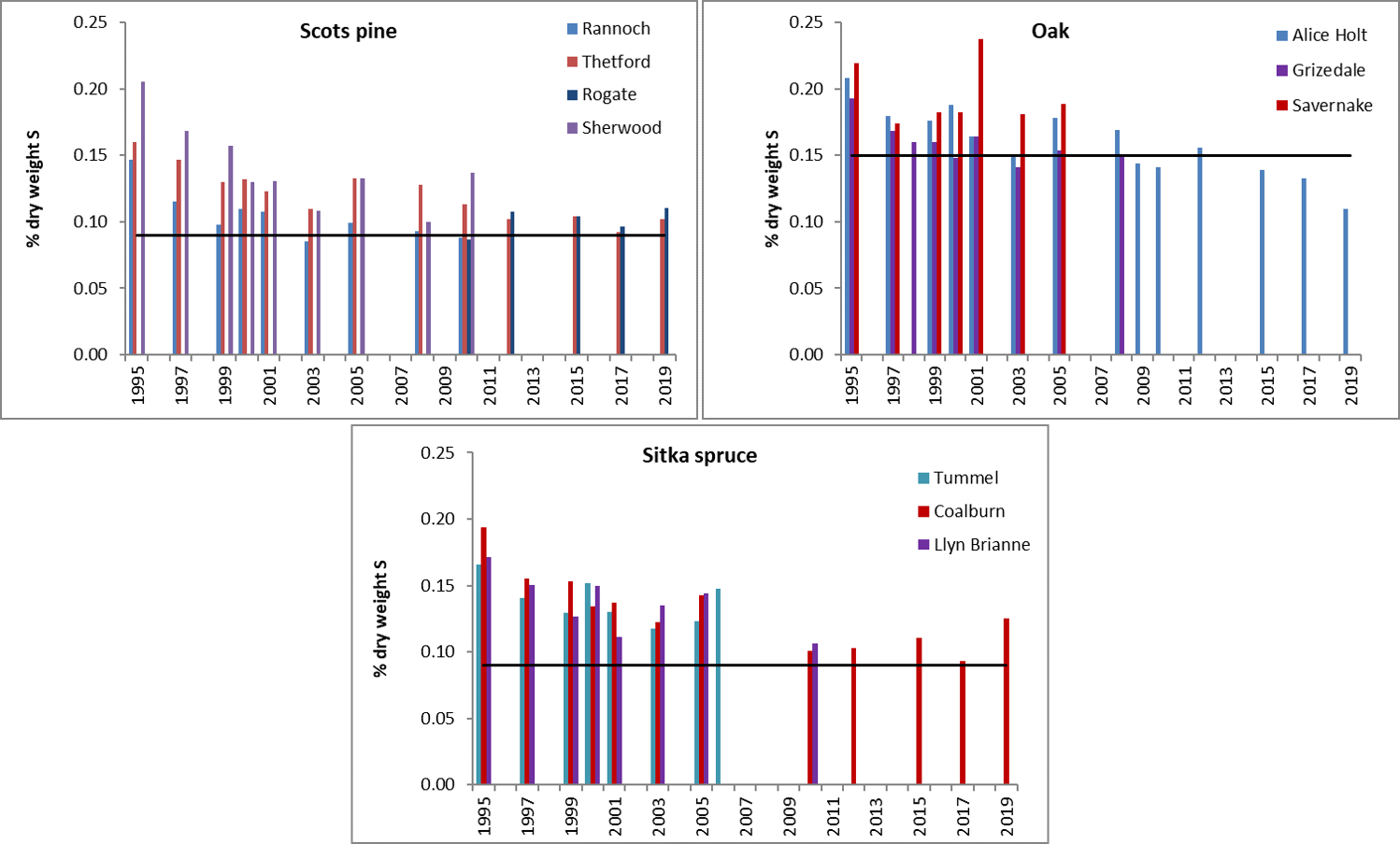Summary
Summary
Foliar chemistry provides an indication of the nutritional status of a tree and tree mineral nutrition has been shown to be deteriorating across Europe.
At the Intensive Forest Monitoring plots, tree foliar chemistry changes can be related to shifts in local environmental conditions. For example, foliar nitrogen concentrations in Scots pine at the Thetford site have exceeded 1.7% of foliar dry weight over the past twenty years, rising to 2.2% in 2002 – a value indicating nutrient imbalance (Gundersen, 1999) and reflecting high levels of nitrogen loading at this site. At Lady Bower and Rannoch foliar nitrogen concentration was initially above 1.7% high but have since declined and levels at other site remain low.

(Graphs showing annual deposition of total nitrogen in throughfall, nitrate levels in soil solution and foliar nitrogen (% of dry weight) at Scots pine and Sitka spruce Intensive Forest Monitoring sites. The red line indicates the concentration below which the species is deemed to be nutrient deficient.)
High nitrogen deposition does not necessarily result in reduced tree growth (Sheppard & Wallander, 2004). However, in the long term ‘super-optimal’ levels of foliar nitrogen remain a concern.
Forest ecosystems in densely populated or agricultural areas, are in many cases enriched with nitrogen, given the role of P (Phosphate) in trees nutrition, many ecosystems are moving towards P limitation as growth stimulated by higher N availability is out striping the availability of P. The oak sites at both Savernake and Grizedale are P deficient reflecting low P availability in the soil. Other essential nutrients such as magnesium, calcium and potassium are at optimal levels, but may decline in the future, especially in infertile soils, as a result of emission reductions. Base cation concentrations in rainfall have already fallen at most sites.
Foliar sulphur levels at one Scots pine site (Rannoch) are now classed as deficient according to Van den Burg (1985). Both the Scots pine at Rogate and the oak site at Grizedale remain borderline. If this downward trend continues, there is a real possibility that large areas of British woodland on sensitive soil types could become sulphur deficient in the foreseeable future.

References
Vanguelova, E.I., Benham, S., Pitman, R., Moffat, A.J., Broadmeadow, M., Nisbet, T., Durrant, D., Barsoum, N., Wilkinson, M., Bochereau, F. and Hutchings, T., 2010. Chemical fluxes in time through forest ecosystems in the UK – Soil response to pollution recovery. Environmental Pollution, 158(5), pp.1857-1869.
Gunderson, P. (1999). Nitrogen status and impact of nitrogen in forests – indicators and their possible use in critical load assessment. Paper presented at Conference on Critical Loads, Copenhagen, November 1999.
Sheppard, L.J. & Wallendar, H. (2004). Atmospheric nitrogen – pollutant or fertilizer? In ‘Plant ecophysiology: Nitrogen Acquisition and Assimilation in Higher Plant’. Edited by S. Amâncio and I. Stulen. Springer Netherlands. Pages 65-98.
Taylor, C.M.A. (1991). Forest fertilisation in Britain. Forestry Commission Bulletin 95. HMSO, London.
Van Den Burg, J. (1985). Foliar analysis for determination of tree nutrient status – a compilation of literature data. Report No 414. Rijksinstituut voor Onderzoek in de Bos – en Landschapsbouw ‘de Dorschkamp’, Wageningen, The Netherlands.
